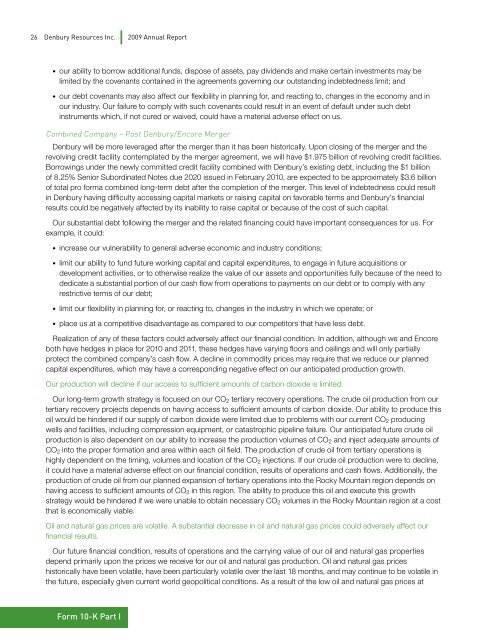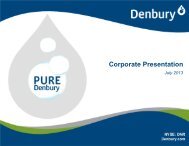Interactive 2009 Annual Report (PDF 7.56 MB) - Denbury Resources ...
Interactive 2009 Annual Report (PDF 7.56 MB) - Denbury Resources ...
Interactive 2009 Annual Report (PDF 7.56 MB) - Denbury Resources ...
- No tags were found...
You also want an ePaper? Increase the reach of your titles
YUMPU automatically turns print PDFs into web optimized ePapers that Google loves.
26 <strong>Denbury</strong> <strong>Resources</strong> Inc. <strong>2009</strong> <strong>Annual</strong> <strong>Report</strong>• our ability to borrow additional funds, dispose of assets, pay dividends and make certain investments may belimited by the covenants contained in the agreements governing our outstanding indebtedness limit; and• our debt covenants may also affect our flexibility in planning for, and reacting to, changes in the economy and inour industry. Our failure to comply with such covenants could result in an event of default under such debtinstruments which, if not cured or waived, could have a material adverse effect on us.Combined Company – Post <strong>Denbury</strong>/Encore Merger<strong>Denbury</strong> will be more leveraged after the merger than it has been historically. Upon closing of the merger and therevolving credit facility contemplated by the merger agreement, we will have $1.975 billion of revolving credit facilities.Borrowings under the newly committed credit facility combined with <strong>Denbury</strong>’s existing debt, including the $1 billionof 8.25% Senior Subordinated Notes due 2020 issued in February 2010, are expected to be approximately $3.6 billionof total pro forma combined long-term debt after the completion of the merger. This level of indebtedness could resultin <strong>Denbury</strong> having difficulty accessing capital markets or raising capital on favorable terms and <strong>Denbury</strong>’s financialresults could be negatively affected by its inability to raise capital or because of the cost of such capital.Our substantial debt following the merger and the related financing could have important consequences for us. Forexample, it could:• increase our vulnerability to general adverse economic and industry conditions;• limit our ability to fund future working capital and capital expenditures, to engage in future acquisitions ordevelopment activities, or to otherwise realize the value of our assets and opportunities fully because of the need todedicate a substantial portion of our cash flow from operations to payments on our debt or to comply with anyrestrictive terms of our debt;• limit our flexibility in planning for, or reacting to, changes in the industry in which we operate; or• place us at a competitive disadvantage as compared to our competitors that have less debt.Realization of any of these factors could adversely affect our financial condition. In addition, although we and Encoreboth have hedges in place for 2010 and 2011, these hedges have varying floors and ceilings and will only partiallyprotect the combined company’s cash flow. A decline in commodity prices may require that we reduce our plannedcapital expenditures, which may have a corresponding negative effect on our anticipated production growth.Our production will decline if our access to sufficient amounts of carbon dioxide is limited.Our long-term growth strategy is focused on our CO 2 tertiary recovery operations. The crude oil production from ourtertiary recovery projects depends on having access to sufficient amounts of carbon dioxide. Our ability to produce thisoil would be hindered if our supply of carbon dioxide were limited due to problems with our current CO 2 producingwells and facilities, including compression equipment, or catastrophic pipeline failure. Our anticipated future crude oilproduction is also dependent on our ability to increase the production volumes of CO 2 and inject adequate amounts ofCO 2 into the proper formation and area within each oil field. The production of crude oil from tertiary operations ishighly dependent on the timing, volumes and location of the CO 2 injections. If our crude oil production were to decline,it could have a material adverse effect on our financial condition, results of operations and cash flows. Additionally, theproduction of crude oil from our planned expansion of tertiary operations into the Rocky Mountain region depends onhaving access to sufficient amounts of CO 2 in this region. The ability to produce this oil and execute this growthstrategy would be hindered if we were unable to obtain necessary CO 2 volumes in the Rocky Mountain region at a costthat is economically viable.Oil and natural gas prices are volatile. A substantial decrease in oil and natural gas prices could adversely affect ourfinancial results.Our future financial condition, results of operations and the carrying value of our oil and natural gas propertiesdepend primarily upon the prices we receive for our oil and natural gas production. Oil and natural gas priceshistorically have been volatile, have been particularly volatile over the last 18 months, and may continue to be volatile inthe future, especially given current world geopolitical conditions. As a result of the low oil and natural gas prices atForm 10-K Part I




